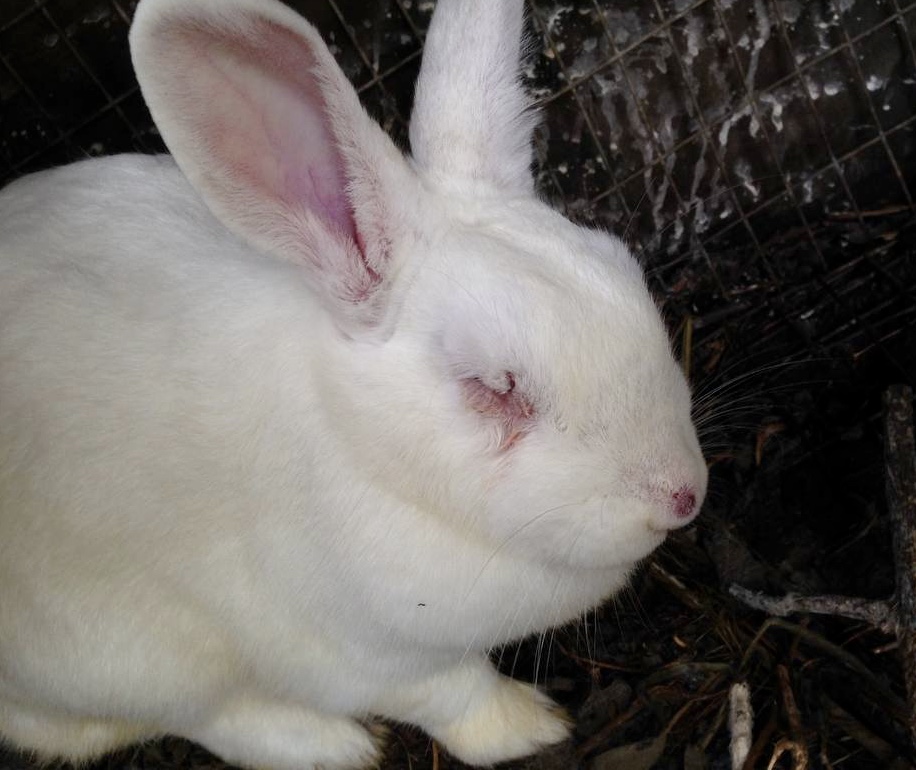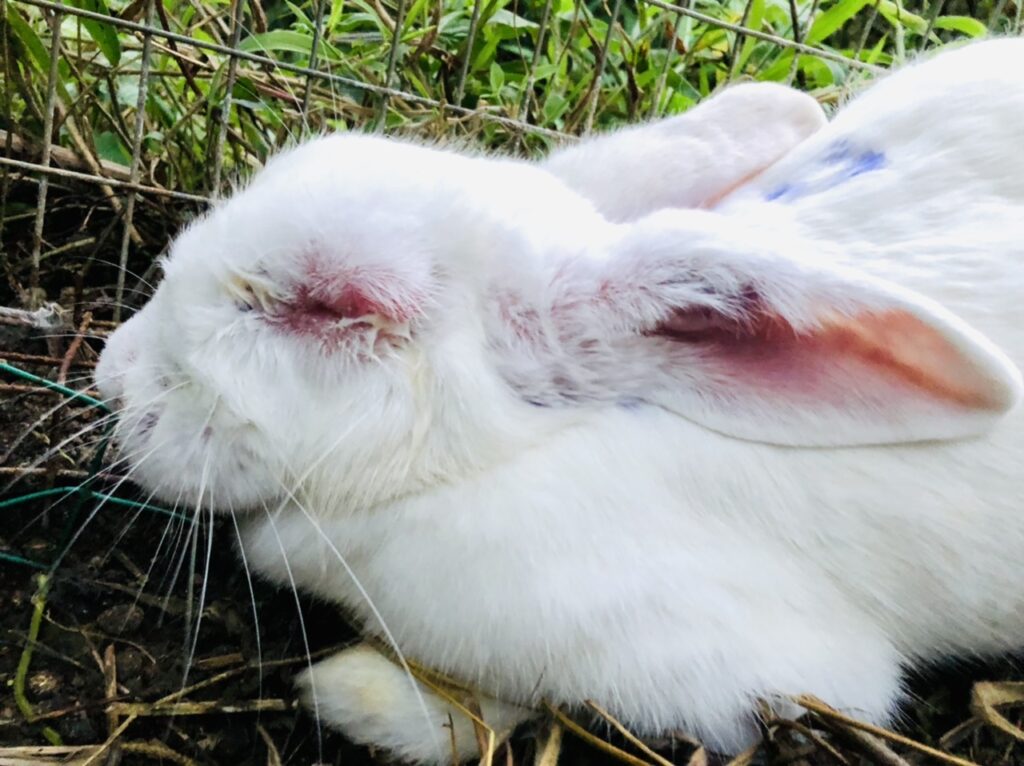Myxomatosis is a highly contagious viral disease, caused by the myxoma virus, that affects rabbits worldwide. Among European domestic rabbits (Oryctolagus cuniculus), the disease is severe and often fatal. Infected rabbits have a mortality rate of about 90-95% (Ross & Sanders, 1977) to 99% (Hudson et al., 1955). However, in its natural host, a type of wild rabbit Sylvilagus spp., the virus is not nearly as harmful, causing only mild disease.
Myxomatosis is spread through close contact with infected animals. It is also commonly transmitted by fleas (Spilopsyllus cuniculi) and mosquitoes. Thus, primary methods for controlling this disease are reducing contact with vectors and wild rabbits, who may carry the disease.
In our experience, the first sign of myxomatosis is typically inflammation and redness in the tissue around the eye. One or both eyes will often be squinted, and have white, goopy discharge. The rabbit may also have a red sore on their nose. The rabbit may seem a bit more lethargic than usual, but often in this preliminary stage of the disease their appetite will not be significantly reduced. It can be easy to confuse these early signs (especially when there is no sore on the nose, and just a bit of redness and discharge in the eye) with conjunctivitis, which unlike myoxomatosis, can be easily treated.

The disease progresses quite quickly, and within a day or two it will be quite obvious that the rabbit is suffering from more than simple conjunctivitis. Both eyes become quite red, with so much inflammation and discharge that the eyes swell shut and the rabbit is blinded. There is swelling of the face, ears, and genital region as the rabbit develops myxomas, or tumors. The rabbit becomes quite lethargic and doesn’t eat much. Their breathing becomes labored, due to the increased swelling and discharge.
By the 4th day, the suffering is obviously quite immense. We typically choose to humanely put the affected rabbit down instead of letting the disease progress further, so they don’t continue to suffer. For reference, one study found average survival times of infected rabbits to be 12.6 days (Sobey et al., 2009).
While myxomatosis is quite deadly and has no known cure, there are a few measures you can take to help prevent infection and spread of this virus among your rabbits.
Most important is to separate affected rabbits immediately when early signs are observed to prevent the spread of the disease to other rabbits. Having a separate cage that can be used to isolate sick (or injured) rabbits from the others is a good general practice when you are raising rabbits, and becomes essential when you are dealing with a highly contagious disease like myxomatosis.
It is important to practice good hygiene when there is outbreak among your rabbits. Avoid handling sick rabbits with the same clothing or gloves you use when feeding and handling the other rabbits. Be sure to keep water bottle and food dishes separated, etc.
It is also important to check all rabbits at least once, but probably a few times each day during, or following an outbreak. This will allow you to observe the earliest signs of illness, and separate the affected rabbit immediately. Regular observation of every single rabbit on your homestead or farm is a good practice, in general, to ensure rabbits are in optimal health and to help contain disease. We do this daily during feedings.
Other possible preventative measures are keeping rabbits indoors so that there is less risk of infection from mosquitoes or wild rabbits, and/or hanging netting on cages to prevente mosquito bites.
Applying Ivermectin could possibly also prevent infection via mosquitoes (Ivermectin has been used to successfully control malaria, another mosquito borne disease).
There is a vaccine for myxomatosis, that can also be utilized to help prevent outbreaks. A comprehensive, 30 year study in Spain found that as the 1,714 commercial farms they visited during the study implemented the vaccine, there was a steady decrease in myxomatosis infections (Rosell et al., 2019). This vaccine is not available in Ecuador, so this is not an option that we have utilized.
We know of a few folks in Vilcabamba who are currently dealing with myxomatosis outbreaks among their rabbits. We have unfortunately lost 3 rabbits since early July. (Two of our favorites — Dahlia & Petunia ). It’s been a few days since Dahlia died and we are holding our breath and hoping no one else is affected.
I’m also making sure all our rabbits get plenty of mineral salts in their oats (we give them each a portion daily), lots of fresh water, and a really nice assortment of fresh wild greens so that their systems are well supported. These are things we already do regularly that help support overall health and vitality. Small amounts of herbs like dandelion, dock, mint, and comfrey are also good additions to help boost resilience.
For more information about raising rabbits, check out my post The Basics of Rabbit Care.
References
Farrell, S., Noble, M.P.J., Pinchbeck, G.L. Brant, B., Caravaggi, A. […], & Radford, A.D. (2020). Seasonality and risk factors for myxomatosis in pet rabbits in Great Britain. Preventive Veterinary Medicine, 176. https://doi.org/10.1016/j.prevetmed.2020.104924.
Hudson, J., Thompson, H., and Mansi, W. Myxoma Virus in Britain. (1955). Nature 176, 783. https://doi.org/10.1038/176783a0
Kerr P.J. (2012). Myxomatosis in Australia and Europe: a model for emerging infectious diseases. Antiviral Research 93(3):387-415. doi: 10.1016/j.antiviral.2012.01.009.
Rosell, J.M., Fernando de la Fuente, L. […], and Fernández Magariños, X.M. (2019). Myxomatosis and Rabbit Haemorrhagic Disease: A 30-Year Study of the Occurrence on Commercial Farms in Spain. Animals, 9(10): 780. https://www.ncbi.nlm.nih.gov/pmc/articles/PMC6827050/#__ffn_sectitle
Ross J. & Sanders M.F. (1977). Innate resistance to myxomatosis in wild rabbits in England. The Journal of Hygiene, (3):411-5. doi: 10.1017/s0022172400053262.
Sobey, W.R., Conolly, D., Haycock, P., and Edwards, J.W. (2009). Myxomatosis: The effect of age upon survival of wild and domestic rabbits (Oryctolagus cuniculus) with a degree of genetic resistance and unselected domestic rabbits infected with myxoma virus. Epidemiology and Infection, 68(1). https://doi.org/10.1017/S002217240002859X


http://slkjfdf.net/ – Itepeq Ebarakin ymn.porp.sierraycielo.org.aec.vt http://slkjfdf.net/